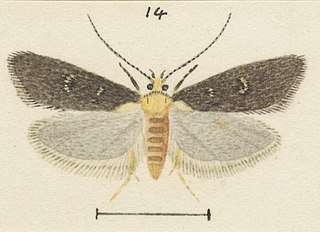
Mesapamea secalis, the common rustic, is a moth of the family Noctuidae. The species was first described by Carl Linnaeus in his 1758 10th edition of Systema Naturae. It is found in Europe, north-west Africa, Turkey and northern Iran.
Batrachedra helarcha is a species of moth of the family Batrachedridae. It is found in Australia.

Cochylichroa atricapitana, the black-headed conch, is a moth of the family Tortricidae. It is found in China (Xinjiang) and the eastern Palearctic and most of Europe.
Agonopterix rubristricta is a moth in the family Depressariidae. It was described by Thomas de Grey, 6th Baron Walsingham, in 1912. It is found in Guatemala.
Dichomeris xerodes is a moth in the family Gelechiidae. It was described by Thomas de Grey, 6th Baron Walsingham, in 1911. It is found in Mexico (Tabasco).
Helcystogramma tegulella is a moth in the family Gelechiidae. It was described by Thomas de Grey, 6th Baron Walsingham, in 1897. It is found in Panama, the West Indies and Guyana.
Recurvaria ostariella is a moth of the family Gelechiidae. It is found in the West Indies, where it has been recorded from Saint Thomas.
Anacampsis conistica is a moth of the family Gelechiidae. It was described by Thomas de Grey, 6th Baron Walsingham, in 1910. It is found in Mexico.
Aristotelia penicillata is a moth of the family Gelechiidae. It was described by Thomas de Grey, 6th Baron Walsingham, in 1897. It is found in West Indies, where it has been recorded from Haiti.
Aristotelia squamigera is a moth of the family Gelechiidae. It was described by Thomas de Grey, 6th Baron Walsingham, in 1909. It is found in Mexico (Guerrero).
Antaeotricha trichonota is a species of moth of the family Depressariidae. It is found in Brazil and Paraguay.
Antaeotricha corvigera is a moth of the family Depressariidae first described by Edward Meyrick in 1915. It is found in Guyana and Peru.
Antaeotricha lysimeris is a moth of the family Depressariidae. It is found in Peru.
Antaeotricha superciliosa is a moth of the family Depressariidae. It is found in French Guiana and Brazil.
Eupragia solida is a moth in the family Depressariidae. It was described by Walsingham in 1911. It is found in Mexico, where it has been recorded from Tabasco.
Antaeotricha milictis is a moth in the family Depressariidae. It was described by Edward Meyrick in 1925. It is found in Colombia and Brazil.

Trachypepla cyphonias is a species of moth in the family Oecophoridae. It is endemic to New Zealand and has been collected in Wellington and Taranaki. Larvae of this species have been reared from kānuka leaf litter. Adults are on the wing in December. This species is classified as "At Risk, Naturally Uncommon" by the Department of Conservation.
Gypsonoma aechnemorpha is a moth of the family Tortricidae first described by Alexey Diakonoff in 1982. It is found in Sri Lanka.

Trachypepla protochlora is a moth of the family Oecophoridae first described by Edward Meyrick in 1883. It is endemic to New Zealand and is found in both the North and South Islands. The preferred habitat of this species is native forest and adults are on the wing from October until February. Adults can be variable in their green shaded colour as well as in the intensity of markings on their forewings. The greenish ground colouration of this moth ensures they are well camouflaged when at rest on green mosses and lichens.

Trachypepla spartodeta is a moth of the family Oecophoridae first described by Edward Meyrick in 1883. It is endemic to New Zealand and has been collected in both the North and South Islands. This species inhabits native forest and adults are on the wing from November to January.




